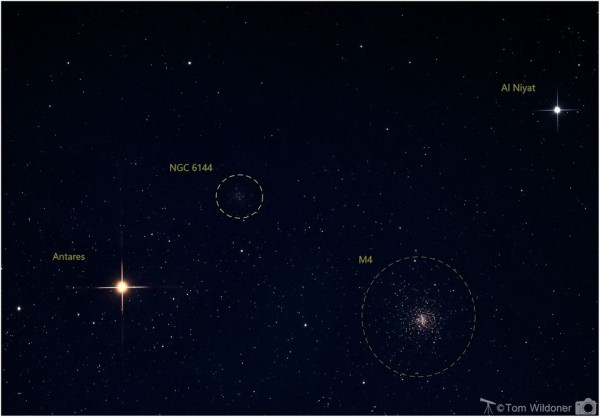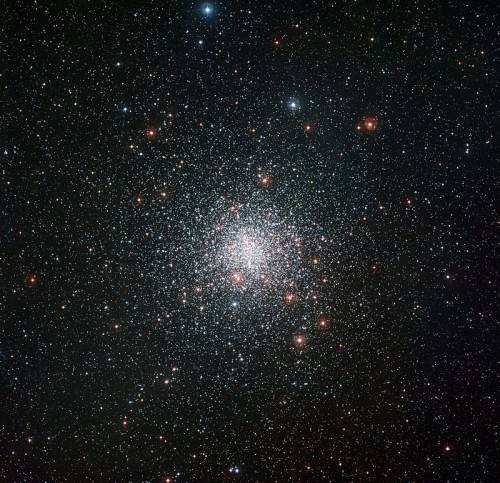
Red Antares – the brightest star in Scorpius the Scorpion and often called the Heart of the Scorpion – is up in the evening now. It’s a bright red star known for twinkling rapidly. If you have binoculars, sweep for an object near Antares on the sky’s dome. This object is called Messier 4 or M4. It’s a globular cluster, one of our galaxy’s oldest inhabitants. M4 has an estimated age of 12.2 billion years, in contrast to about 4.5 billion years for our sun.
If you’ve never found a deep-sky object on your own before, M4 is a grand place to start. Northern Hemisphere summer evenings – or Southern Hemisphere winter evenings – are probably your best bet for catching M4. The M4 globular star cluster is easy to find, because it’s right next to the first-magnitude star Antares, the brightest in the constellation Scorpius the Scorpion.
Your first step to locating M4 is to find Antares, the Scorpion’s heart star.

View at EarthSky Community Photos. | EarthSky friend Dr Ski in the Philippines caught M4 near the red star Antares back in April, when they were in the morning sky. He wrote: “Red giant Antares with its globular cluster companion M4. A feast for the eyes through any instrument!” Thank you, Dr Ski!
Antares and M4 are best seen from around the globe in the months around July. In early June, Antares is highest in the sky around midnight (1 a.m. daylight saving time). That means it’s high in the south for Northern Hemisphere viewers, and overhead for Southern Hemisphere viewers.
The stars return to the same place in the sky some two hours earlier every month. So Antares is highest up around 10 p.m. (11 p.m. daylight saving time) in early July, and 8 p.m. (9 p.m. daylight saving time) in early August.
You might glimpse M4 with the unaided eye on a very dark, moonless night, from a country location. If you can’t spot it, use binoculars to sweep for it.
Antares and M4 readily fit inside the same binocular field of view, with M4 appearing a bit more than 1 degree to the west (or right) of Antares. For reference, a typical binocular field has a diameter of 5 to 6 degrees. M4 looks like a rather dim, hazy star in binoculars.
Once you spot it, you might begin longing for a telescope to be able to resolve this fuzzy cluster into a clump of starry pinpoints.

A 5-minute stacked image of Antares and the surrounding region including the globular cluster Messier 4 (M4). Photo by our friend Tom Wildoner at the Dark Side Observatory.
History and science of M4. The comet hunter Charles Messier (1730-1817) listed M4 as object #4 in his famous Messier catalog. The Messier catalog listed over 100 deep-sky objects that look like comets, but really aren’t. Charles Messier wanted to steer comet hunters away from these faint fuzzies that masquerade as comets.
Modern astronomy tells us that M4 is a globular star cluster – a globe-shape stellar city packed with perhaps a hundred thousand stars. Unlike open star clusters – such as the Pleiades and the Hyades – the Milky Way galaxy’s 200 or so globular star clusters are not part of the galactic disk.
Instead, globular clusters populate the galactic halo – the sphere-shaped region of the Milky Way circling above and below the pancake-shaped galactic disk.
At about 7,000 light-years from Earth, M4 is one of the two closest globular clusters to our sun and Earth (the other is NGC 6397). That’s among the Milky Way’s 200 or so globular clusters. Most globulars reside tens of thousands of light-years away. The farthest of globular clusters, M54, is thought to be 70,000 light-years distant.
M4 is about 75 light-years across.
Globular clusters are tightly packed with tens to hundreds of thousands of stars, whereas open clusters are loosely-bound stellar confederations with only a few hundred to a thousand stars. Globular clusters contain primitive stars that are billions of years old and almost as old as the universe itself. On the other hand, open clusters consist of young, hot stars that tend to disperse after hundreds of millions of years.

Messier 4 or M4. Image via European Southern Observatory.
M4’s position is at Right Ascension: 16h 23.6m; Declination: 26 degrees 32′ south
Bottom line: M4 or Messier 4 is a globular star cluster, one of the nearest to our solar system. It’s also one of the easiest of all globular clusters to find.
from EarthSky https://ift.tt/30SdRw8

Red Antares – the brightest star in Scorpius the Scorpion and often called the Heart of the Scorpion – is up in the evening now. It’s a bright red star known for twinkling rapidly. If you have binoculars, sweep for an object near Antares on the sky’s dome. This object is called Messier 4 or M4. It’s a globular cluster, one of our galaxy’s oldest inhabitants. M4 has an estimated age of 12.2 billion years, in contrast to about 4.5 billion years for our sun.
If you’ve never found a deep-sky object on your own before, M4 is a grand place to start. Northern Hemisphere summer evenings – or Southern Hemisphere winter evenings – are probably your best bet for catching M4. The M4 globular star cluster is easy to find, because it’s right next to the first-magnitude star Antares, the brightest in the constellation Scorpius the Scorpion.
Your first step to locating M4 is to find Antares, the Scorpion’s heart star.

View at EarthSky Community Photos. | EarthSky friend Dr Ski in the Philippines caught M4 near the red star Antares back in April, when they were in the morning sky. He wrote: “Red giant Antares with its globular cluster companion M4. A feast for the eyes through any instrument!” Thank you, Dr Ski!
Antares and M4 are best seen from around the globe in the months around July. In early June, Antares is highest in the sky around midnight (1 a.m. daylight saving time). That means it’s high in the south for Northern Hemisphere viewers, and overhead for Southern Hemisphere viewers.
The stars return to the same place in the sky some two hours earlier every month. So Antares is highest up around 10 p.m. (11 p.m. daylight saving time) in early July, and 8 p.m. (9 p.m. daylight saving time) in early August.
You might glimpse M4 with the unaided eye on a very dark, moonless night, from a country location. If you can’t spot it, use binoculars to sweep for it.
Antares and M4 readily fit inside the same binocular field of view, with M4 appearing a bit more than 1 degree to the west (or right) of Antares. For reference, a typical binocular field has a diameter of 5 to 6 degrees. M4 looks like a rather dim, hazy star in binoculars.
Once you spot it, you might begin longing for a telescope to be able to resolve this fuzzy cluster into a clump of starry pinpoints.

A 5-minute stacked image of Antares and the surrounding region including the globular cluster Messier 4 (M4). Photo by our friend Tom Wildoner at the Dark Side Observatory.
History and science of M4. The comet hunter Charles Messier (1730-1817) listed M4 as object #4 in his famous Messier catalog. The Messier catalog listed over 100 deep-sky objects that look like comets, but really aren’t. Charles Messier wanted to steer comet hunters away from these faint fuzzies that masquerade as comets.
Modern astronomy tells us that M4 is a globular star cluster – a globe-shape stellar city packed with perhaps a hundred thousand stars. Unlike open star clusters – such as the Pleiades and the Hyades – the Milky Way galaxy’s 200 or so globular star clusters are not part of the galactic disk.
Instead, globular clusters populate the galactic halo – the sphere-shaped region of the Milky Way circling above and below the pancake-shaped galactic disk.
At about 7,000 light-years from Earth, M4 is one of the two closest globular clusters to our sun and Earth (the other is NGC 6397). That’s among the Milky Way’s 200 or so globular clusters. Most globulars reside tens of thousands of light-years away. The farthest of globular clusters, M54, is thought to be 70,000 light-years distant.
M4 is about 75 light-years across.
Globular clusters are tightly packed with tens to hundreds of thousands of stars, whereas open clusters are loosely-bound stellar confederations with only a few hundred to a thousand stars. Globular clusters contain primitive stars that are billions of years old and almost as old as the universe itself. On the other hand, open clusters consist of young, hot stars that tend to disperse after hundreds of millions of years.

Messier 4 or M4. Image via European Southern Observatory.
M4’s position is at Right Ascension: 16h 23.6m; Declination: 26 degrees 32′ south
Bottom line: M4 or Messier 4 is a globular star cluster, one of the nearest to our solar system. It’s also one of the easiest of all globular clusters to find.
from EarthSky https://ift.tt/30SdRw8



Aucun commentaire:
Enregistrer un commentaire